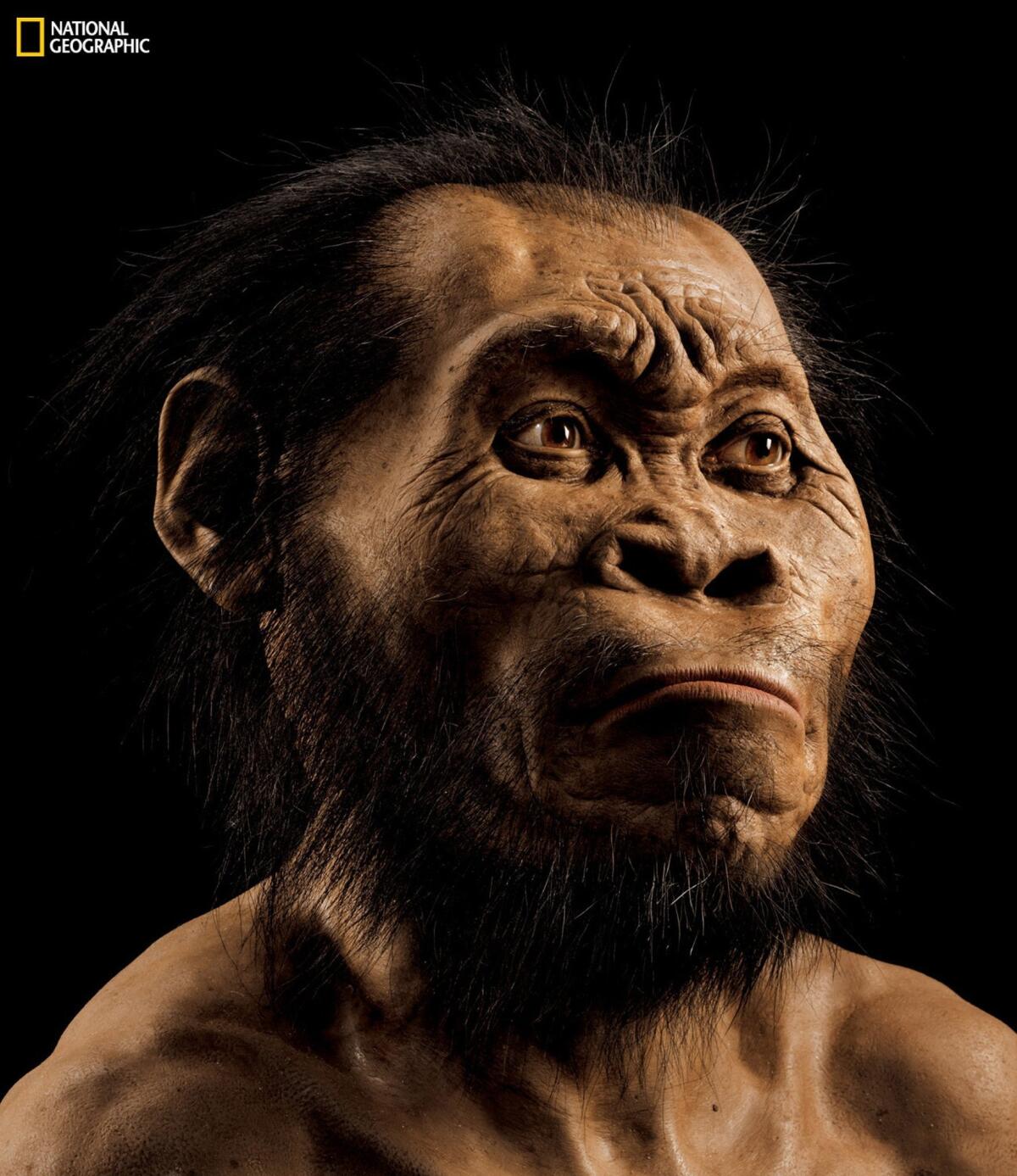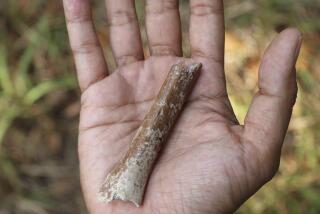Scientists discover new human species relative: Homo naledi

This photo provided by National Geographic from their October 2015 issue shows a reconstruction of Homo naledi’s face by paleoartist John Gurche at his studio in Trumansburg, N.Y. Scientists say fossils found deep in a South African cave revealed the new member of the human family tree.
- Share via
Reporting from MAGALIESBURG, South Africa — Scientists say they’ve discovered a new member of the human family tree, revealed by a huge trove of bones in a barely accessible, pitch-dark chamber of a cave in South Africa.
The creature shows a surprising mix of human-like and more primitive characteristics — some experts called it “bizarre” and “weird.”
And the discovery presents some key mysteries: How old are the bones? And how did they get into that chamber, reachable only by a complicated pathway that includes squeezing through passages as narrow as about 7½ inches?
The site, about 30 miles northwest of Johannesburg, has yielded some 1,550 specimens since its discovery in 2013. The fossils represent at least 15 individuals.
NEWSLETTER: Get the day’s top headlines from Times Editor Davan Maharaj >>
Researchers named the creature Homo naledi [nah-LEH-dee]. That reflects the “Homo” evolutionary group, which includes modern people and our closest extinct relatives, and the word for “star” in a local language. The find was made in the Rising Star cave system.
The creature, which evidently walked upright, represents a mix of traits. For example, the hands and feet look like Homo, but the shoulders and the small brain recall Homo’s more ape-like ancestors, the researchers said.
Lee Berger, a professor at the University of the Witwatersrand in Johannesburg who led the work, said Homo naledi’s anatomy suggest that it arose at or near the root of the Homo group, which would make the species some 2.5 million to 2.8 million years old. The discovered bones themselves may be younger, he said.
The researchers announced the discovery Thursday in the journal eLife and at a news conference in the Cradle of Humankind, a site near the village of Magaliesburg. They said they were unable to determine an age for the fossils because of unusual characteristics of the site, but they are still trying.
Berger said researchers are not claiming that Homo neledi was a direct ancestor of modern-day people, and experts unconnected to the project said they believed it was not.
Rick Potts, director of the human origins program at the Smithsonian Institution’s Natural History Museum, who was not involved in the discovery, said that without an age, “there’s no way we can judge the evolutionary significance of this find.”
If the bones are about as old as the Homo group, that would argue that H. naledi is “a snapshot of ... the evolutionary experimentation that was going on right around the origin” of Homo, he said. If they are significantly younger, it either shows the naledi retained the primitive body characteristics much longer than any other known creature, or that it re-evolved them, he said.
Eric Delson of Lehman College in New York, who also wasn’t involved with the work, said his guess is that H. naledi fits within a known group of early Homo creatures from around 2 million year ago.
Besides the age of the bones, another mystery is how they got into the difficult-to-reach area of the cave. The researchers said they suspect the H. naledi may have repeatedly deposited their dead in the room, but alternatively it may have been a death trap for individuals that found their own way in.
“This stuff is like a Sherlock Holmes mystery,” declared Bernard Wood of George Washington University in Washington, D.C., who was not involved in the study. Visitors to the cave must have created artificial light, as with a torch, Wood said. The people who did cave drawings in Europe had such technology, but nobody has suspected that mental ability in creatures with such a small brain as H. naledi, he said.
Potts said a deliberate disposal of dead bodies is a feasible explanation, but he added it’s not clear who did the disposing. Maybe it was some human relative other than H. naledi, he said.
Not everybody agreed that the discovery revealed a new species. Tim White of UC Berkeley called that claim questionable. “From what is presented here, [the fossils] belong to a primitive Homo erectus, a species named in the 1800s,” he said in an email.
ALSO
The biology of crime: Low heart rate may predict criminal behavior, study says
Research offers promise for breaking the link between obesity and insulin resistance
E-cigarettes: Teens who vape are more likely to smoke later, study says





